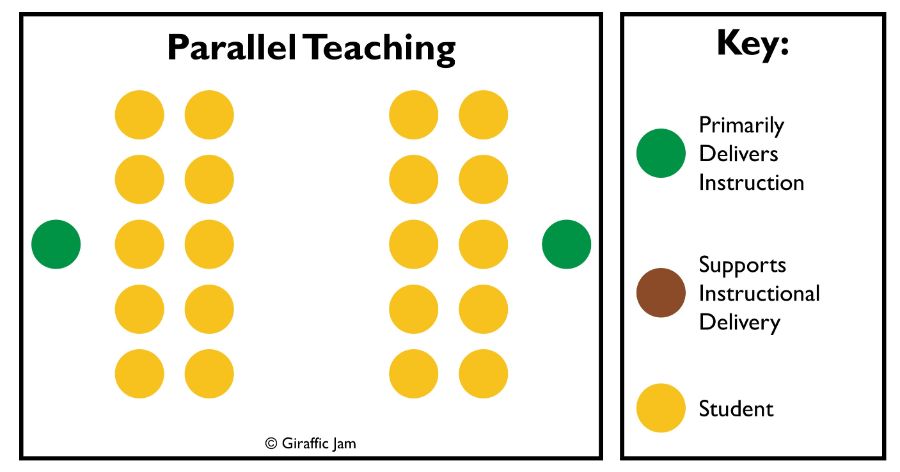
Parallel teaching is a great co-teaching strategy to try. It’s a perfect strategy to try for those new to co-teaching. Parallel teaching is when the exact same lesson is being taught at the exact same time by two different teachers.
There are six different types of co-teaching. No matter which of the types of co-teaching you use, you and your co-teacher can be highly effective instructors when you work together to plan and deliver lessons. Co-teaching works, because it involves two adults actively working together to provide instruction.
Simply put, co-teaching is when two adults work together to teach a lesson. Notice, I say ‘adults’ not teachers. Why? It’s simple really, it could be two teachers. Or, it could be an intern and a teacher… A substitute and a teacher… An instructional assistant and a teacher. Or, a substitute and an instructional assistant. Or…..
Well, I guess you get where I’m going with this. However, old habits die hard so throughout this post you’ll see me refer to the adults as ‘teachers’. Just don’t limit yourself to thinking of teachers only in the traditional sense!
Don’t be limited to thinking that co-teaching is always a gen ed teacher and a special education teacher. It can be, but it doesn’t have to be. If you think outside the box, you might find that you have more opportunities for co-teaching than you realize!
Parallel teaching is dividing the class in half and having each teacher providing the exact same instruction to their half. Groups do not rotate, because everyone is receiving the same instruction. Think of it as taking your class of 20 students and making it into two classes of ten.

When parallel teaching, the entire class is divided into two equal groups. Each group receives the exact same instruction and material. Groups do not rotate.
Smaller class sizes – do I need to say more?!
Parallel teaching is like having two small classes, instead of one large class. Kids have more opportunities to participate and engage with instruction. It’s much easier for the teacher to notice which students are ‘getting it’ and which students might need more support. Particularly when doing something demonstration based, for instance a science experiment, students are typically able to see better because there’s less of them crowding around the demo.
This type of teaching requires both teachers to equally be involved in both the planning and the implementation of the lesson. If you don’t have a lot of co-planning time, it can be near impossible for someone to walk into the room, pick up the lesson, and teach it. Timing must also be similar – you don’t want one teacher to finish the lesson while the other still has 15 minutes left of material to teach.
Co-Teaching can be hard. If you’re looking for more information, check out this blog post to read some of my favorite tips and tricks for getting the ball rolling!
Co-teaching is an effective tool for reaching all of your learners. It allows both teachers the opportunity to see students and their progress. When you use parallel teaching as your co-teaching method, it gives the students the chance to see the lesson in a smaller group setting. Did you know there are five other types of co-teaching? Check them out here!